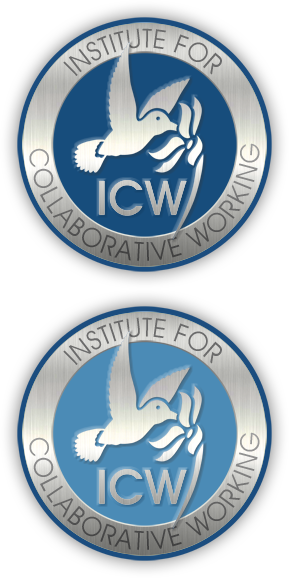Internal Collaboration: The Starting Point for Better External Collaboration31 Jan 2022by Stuart Maister, on behalf of the ICW Thought Leadership Special Interest Group
Our conclusion is that exactly the same applies to organisations. The body corporate is like the body corporeal. Those leaders who want their organisations and teams to work more collaboratively with external parties will fail unless they get their own people to have a highly collaborative mindset internally too. It goes further. The leadership has to adopt the same philosophy: it starts with them. If they understand the power of collaborative working then they must demonstrate collaborative behaviours. It is never enough to come up with worthy sounding directives if this is not reflective of the way they really act and make decisions. 'Do as I do not as I say' is the driving factor in effective leadership. And the evidence is that a more collaborative, enabling approach leads to a more motivated and happier team who prefer this way of working. People like it and this has real business benefit. The Thought Leadership SIG of the ICW has looked at this in detail and identified both the poor outcomes that result from a lack of internal collaboration and a framework to provide the basis for driving improvement. Working as a group not a teamMost organisations do not operate as a single, aligned team but as a series of parallel departments and business units all focused on their own goals and objectives. They have the characteristics of a Group not a Team. Indeed, many internal relationships can be highly transactional rather than collaborative - 'when we need you we'll call'; 'I didn't know we did that'; can you deliver to me xxx?' We've looked at the damage this does and broken it down into three categories:
Taken together, these symptoms, outcomes and costs also make the organisation less able to collaborate with external clients and partners. Think about situations where you have seen this: a JV or key client situation where internal challenges got in the way of being able to openly and proactively engage in the interests of the relationship, and therefore create greater value for everyone. If you are always looking over your shoulder at the internal transactional pressures, then this restricts your ability to open up new possibilities with other organisations. If you are not trusted how can you trust others? A framework for tackling thisSo where do you start if you choose to tackle this? We have developed a simple but powerful framework to provide a structure and process. It breaks down into the three 'E's:
Let's look in a little more detail at each of these. EnactThis is about leadership. The starting point for this approach is that the leadership hard-wires collaborative working into the organisation through its own actions and a proactive approach to creating the right culture. Of course, this involves capturing this in the key documents such as the strategy, mission and values. That creates the 'why's' which lead to the 'how's'. However, words in these documents do not always translate into actual behaviours. The behaviours of the leadership and a continual drive to create the right culture - through the Engage and Enable strands - will be required to turn this into 'the way we do things around here'. Management guru Peter Drucker said "culture eats strategy for breakfast" and that's where the focus should be. EngageThis is about structure and process. The strategic objectives of the organisation and individual teams can be linked to the drive for higher levels of collaboration - as long as there is also support for people in how to achieve these. It's not enough to mandate collaboration, as if it is simply a new rule to follow. There needs to be training in the skills involved, open discussion about what this means in practice, and potentially changes to the incentivisation and accountability measurements that drive different behaviours. Without these the ambition is just more warm words. EnableThis is about communication. It's important the successful collaboration is celebrated and communicated while failures are called out. The importance of clarity cannot be overstated, and so by identifying what this looks like in practice we continue to explain how important it is and how everyone can practice higher levels of collaborative behaviours. Communication comes in many forms. The way the offices are designed, for example, tells everyone how work should be carried out. Covid is changing the way we all see offices, with collaboration at the centre of new design because individual working can as effectively be done from home in many cases. This is an opportunity to really drive teamwork and consciously develop an approach which put this at the centre of working practices, connected to the reward system and other measurements as outlined above. A BenchmarkA good starting point for this is to benchmark the organisation in each of these three areas, Enact, Engage and Enable. We have developed a survey which can be used to assess the current state of play by getting detailed feedback from colleagues. This will provide real data to drive prioritisation. Want to access the survey and learn more? Explore our next blog post: coming soon!Post Covid - an opportunity to accelerate internal collaborationWe believe these conclusions would be true any time, but the pandemic has highlighted the best and worst aspects of internal collaboration in many organisations. People have missed working in teams; there's an evolving sense of consciously dividing working time between working with others and working alone to design a new hybrid working; some organisations have demonstrated total trust in their people while others have done the exact opposite. So many working practices which grew up over decades are now being questioned. That provides an opportunity to recreate the working culture of your organisation. Our thinking is that a conscious, deliberate drive to develop higher levels of internal collaboration will tackle the damage we identified as part of our work and provide a foundation for more productive external collaboration as well. |

 If you've ever done any kind of personal development or spiritual exploration, there is always the same core message. Start with yourself. Look inside. When you get yourself right you are better able to have a positive impact on the world.
If you've ever done any kind of personal development or spiritual exploration, there is always the same core message. Start with yourself. Look inside. When you get yourself right you are better able to have a positive impact on the world.